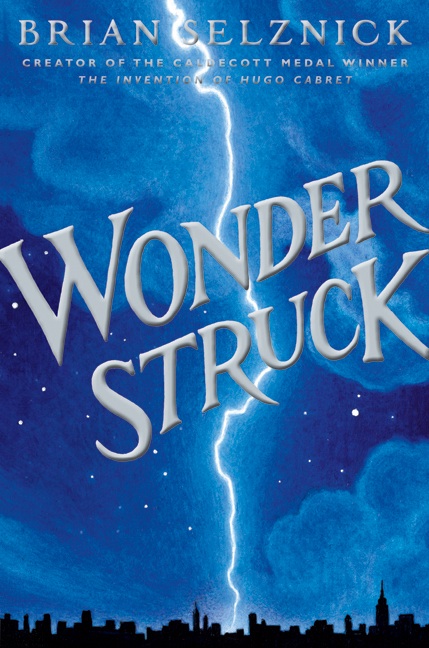Book Jacket:
Ever since his mom died, Ben feels lost.
At home with her father, Rose feels alone.
He is searching for someone, but he is not sure who.
She is searching for something, but she is not sure what.
When Ben finds a mysterious clue hidden in his mom’s room,
When a tempting opportunity presents itself to Rose
Both children risk everything to find what’s missing.
You can read an excerpt here.
Review:
Selznick delivers another lovely story in his patented style – part in words, part in pictures. Wonderstruck may have a little less mystique and a little less grandeur than Hugo Cabret, but it is a worthy successor nonetheless.
No one can deny the quality of Selznik’s illustrations, or the cinematic style he employs in the illustrated sections of his books, but honestly with Hugo Cabret I found myself at times chafing against the lack of words. The graphic-novel style passages were gorgeously done, but personally I would have been equally happy with words and illustrations in the classic style. Wonderstruck however is completely and utterly brilliant in how Selznick’s style and form enhances and informs his story, which revolves around two children who are deaf. The story of Rose, who has been deaf since birth, is told almost entirely in pictures, and it is an absolutely genius way to represent how she sees the world. Wonderstruck is the perfect story for Selznick’s style of storytelling.
Much like Hugo Cabret, Wonderstruck tells the story of two orphans searching for a place where they can belong. With a loving nod at From The Mixed Up Files of Mrs. Basil E. Frankweller, Selznick takes us on a lovely expedition of discovery that brings both our leads to the American Museum of Natural History in New York. Brimming with cabinets and curios a plenty, Selznick has created a story full of nooks and crannies that are marvelous to explore, bursting with the unexpected and steeped in history. As a life-long museum nerd, I’ll admit I’m a softie when it comes to a museum story, but here Selznick once again demonstrates his affinity for creating stories that impart a childlike sense of wonder.
The dual narrators of this book, Rose and Ben, may be decades apart but their emotional journeys resonate nicely. Both children dare to journey past their own horizons and it’s fun to watch how their discoveries lead them separately to the same place. I enjoyed both characters very much, and found I didn’t mind at all that it took most of the book for the stories to overlap (and yes, it’s fairly easy to predict how they will). Overall there are a few coincidences that skirt on being rather too convenient (I’m looking at you, lightning bolt), but the sweet and heartfelt nature of this story is impossible to resist.
If Hugo Cabret was a story about how movie magic touches us in the real world, then Wonderstruck is a story about exploration, be it through a museum display or your own hands and feet. It is inherently a less flashy kind of story – and all around there is less action to this book – which I think might lead some to prefer Hugo Cabret, but for me, this book is my favorite of the two.
In the end, Wonderstruck is a quiet, old fashioned kind of story that is simply lovely to read.
Byrt Grade: A-
As Levar Burton used to say – you don’t have to take my word for it…
Publishers Weekly (starred review) says:
Selznick masterfully uses pencil and paper like a camera, starting a sequence with a wide shot and zooming in on details on successive pages. Key scenes occur when the runaways find themselves in one of Manhattan’s storied museums, and with one character named Jamie, and Rose’s surname being Kincaid, it’s impossible not to think of E.L. Konigsburg’s From the Mixed-up Files of Mrs. Basil E. Frankweiler, to which Selznick tips his hat in an author’s note. Like that Newbery winner, Selznick’s story has the makings of a kid-pleasing classic.
Hugo brought the bygone excitement of silent movies to children; Wonderstruck shows them the thrilling possibilities of museums in a way Night at the Museum doesn’t even bother to.
I love Selznick’s trademark themes – the orphan puzzling things out, the references to the movies, the unique settings, the importance of an older person to a younger, the cinematic quality of the story-telling. Beautifully done!








Wonderstruck tells the parallel stories of two isolated, hearing-impaired children, one in pictures, and one in words, until the two stories meet in a sweet, satisfying way. For young readers, the heft of this book may look daunting, but with all of the illustrations, it reads much more quickly than a similarly sized Harry Potter novel. I liked the illustrations and was interested in how evocative a story could be told with minimal words, but personally I was most drawn in by Ben’s story, which was written in prose. It felt very authentic to the mindset of childhood, with both realistic emotion and a sense of possibility – the hopefulness that magic and stories could come true. Both children’s stories are infused with hope and wonder, and there is enough storybook-style resolution to satisfy in the end. (Dreams coming true in New York City is a classic American fairy tale, after all.) I love that Selznick shows and encourages finding wonder in museums, observation and collecting – all things children can go out and experience for themselves. Adults, too, may find this novel helps them to shed a few layers of jadedness in looking at the world. Oooh, cool!